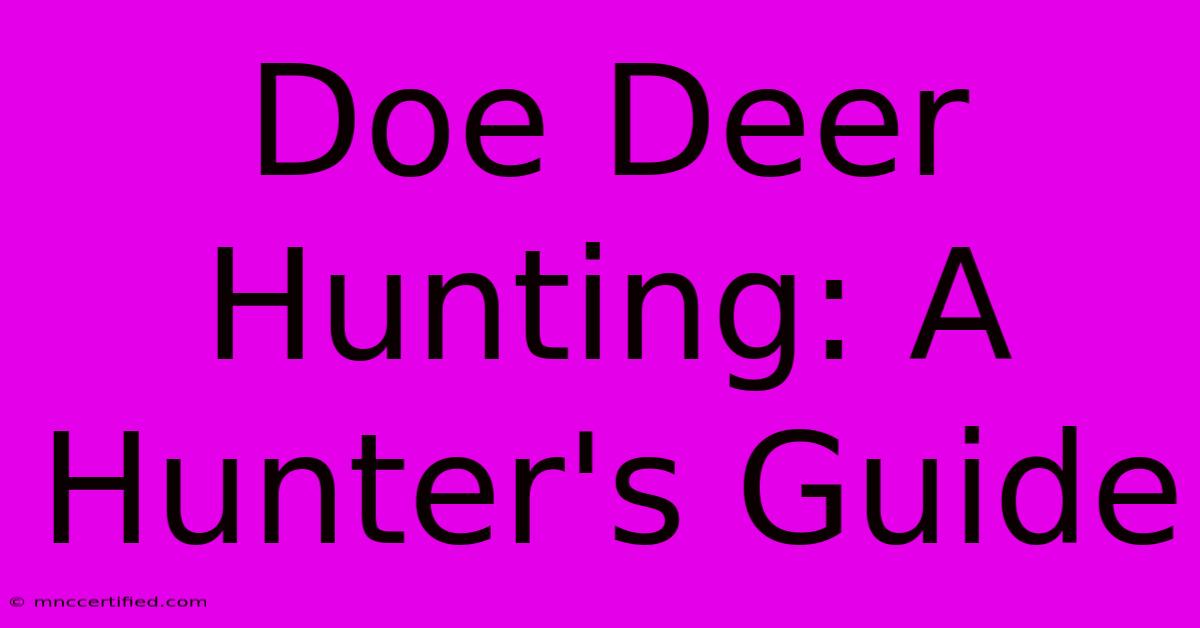Doe Deer Hunting: A Hunter's Guide

Table of Contents
Doe Deer Hunting: A Hunter's Guide
Doe deer hunting presents unique challenges and rewards compared to buck hunting. Understanding doe behavior, employing effective strategies, and adhering to ethical hunting practices are crucial for a successful and responsible hunt. This comprehensive guide will equip you with the knowledge and techniques to increase your chances of a successful doe harvest.
Understanding Doe Deer Behavior
Understanding doe behavior is paramount to successful hunting. Unlike bucks, which are often driven by rutting behavior, does are primarily focused on survival and raising their fawns. This influences their movement patterns, feeding habits, and overall behavior.
Key Behavioral Traits:
- Highly Adaptive: Does are highly adaptable to their environment and can change their routines based on food availability, predator pressure, and human activity.
- Social Animals: Does often live in small groups, offering opportunities for multiple harvests if legal. However, this also means careful shot placement is vital to avoid injuring other deer.
- Feeding Patterns: Does typically feed in the early morning and late evening, especially during the breeding season when energy demands are high. They also browse throughout the day, utilizing a wider range of food sources.
- Fawn Protection: Does are fiercely protective of their fawns. Hunters should be aware of this instinct, as it can influence their movement and alertness.
Strategic Doe Deer Hunting Techniques
Employing effective strategies significantly increases your chances of success. Consider these techniques:
1. Scouting and Location Selection:
- Identify food sources: Look for areas with abundant browse, such as oak trees, apple trees, and agricultural fields. These areas are prime feeding locations.
- Observe trails and bedding areas: Doe deer frequently use established trails leading to and from feeding areas. Bedding areas offer opportunities for ambush hunting.
- Consider wind direction: Wind is crucial. Always position yourself downwind of your target to avoid alerting the deer to your presence.
2. Hunting Methods:
- Still Hunting: This involves slowly and silently moving through the woods, observing your surroundings for signs of deer activity. Patience is key.
- Stand Hunting: Setting up a tree stand or ground blind near known deer trails or feeding areas allows for extended observation and ambush opportunities.
- Drive Hunting: This method involves pushing deer towards waiting hunters. It requires careful coordination and a thorough understanding of the terrain.
3. Gear and Equipment:
- High-quality firearm or bow: Choose a weapon appropriate for the hunting conditions and your skill level. Accurate shot placement is critical for a quick and clean kill.
- Camouflage clothing: Blend in with your surroundings to avoid detection.
- Scent control: Minimize human scent by using scent-eliminating sprays and clothing.
- Binoculars and rangefinder: Essential for spotting deer at a distance and determining the appropriate shot range.
Ethical Considerations in Doe Deer Hunting
Ethical hunting practices are paramount. This includes:
- Understanding hunting regulations: Always check your state's hunting regulations regarding doe hunting seasons, bag limits, and legal hunting methods.
- Accurate shot placement: Aim for vital areas to ensure a quick and humane kill. Avoid shots at long distances or at angles that could result in a wounded animal.
- Respect for wildlife: Treat all animals with respect, regardless of whether you harvest them.
- Proper field dressing and meat handling: Properly field dress the animal to minimize spoilage and maintain the quality of the meat.
Boosting Your Chances: Advanced Tactics
- Hunting during the pre-rut: Does are often more active and less cautious before the rutting season begins.
- Utilizing trail cameras: Trail cameras can help you identify deer movement patterns, feeding areas, and the best locations for your stand.
- Understanding the terrain: Learn the land you are hunting. This will aid in predicting deer movement and improving your hunting success.
Conclusion: A Successful Doe Deer Hunt
Doe deer hunting requires preparation, patience, and a deep understanding of deer behavior. By carefully scouting, employing effective hunting techniques, and adhering to ethical hunting practices, you can significantly increase your chances of a successful and responsible harvest. Remember, responsible hunting contributes to healthy wildlife populations and sustainable hunting practices for years to come. Always prioritize safety and ethical considerations above all else.

Thank you for visiting our website wich cover about Doe Deer Hunting: A Hunter's Guide. We hope the information provided has been useful to you. Feel free to contact us if you have any questions or need further assistance. See you next time and dont miss to bookmark.
Featured Posts
-
Ronaldo Double Al Nassr Near Acl
Nov 26, 2024
-
Enhanced Nile River Tours New Partnership
Nov 26, 2024
-
U Conns Future At Maui Invitational
Nov 26, 2024
-
Barbara Taylor Bradford A Tribute
Nov 26, 2024
-
Barbara Taylor Bradfords Inspiring Journey
Nov 26, 2024